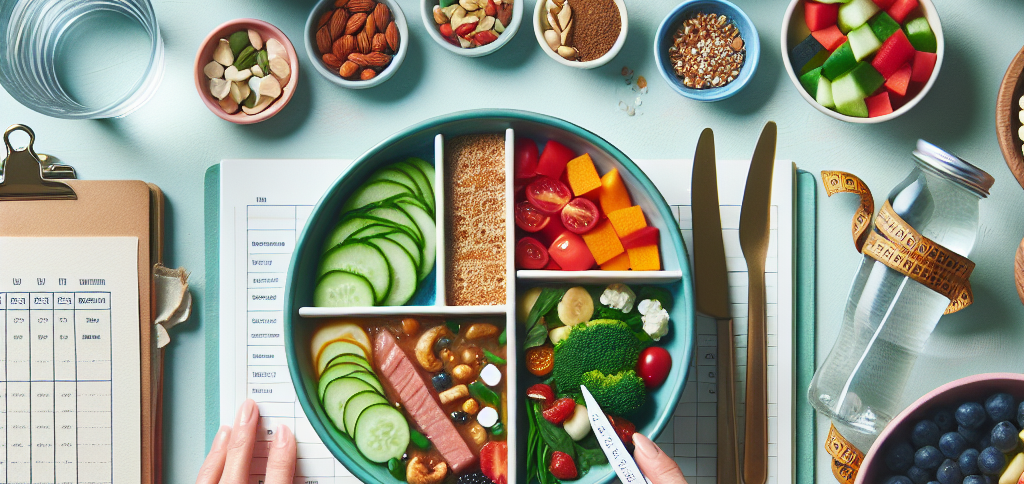Title: 10 Essential Tips for Mastering Portion Control
In a world where indulgence is at our fingertips and supersized meals are the norm, mastering portion control can be your secret weapon for maintaining a healthy lifestyle. It’s not about deprivation, but about understanding and managing how much you consume. Here, we delve into the ten most effective strategies to take charge of your portion sizes, allowing you to enjoy your meals without guilt. Curious for more in-depth insights? Click Here to learn more.
1. Educate Yourself on Serving Sizes
Understanding the difference between a portion and a serving size is crucial. A serving size is a standardized amount recommended on nutrition labels, whereas a portion is the amount you choose to eat. By familiarizing yourself with serving sizes, you can better gauge how much you’re actually consuming. This knowledge is power, helping to ensure that a bowl of cereal doesn’t inadvertently become three servings worth.
2. Use Smaller Plates and Bowls
Psychology plays a significant role in how we perceive portion sizes. Larger plates can make a moderate portion look unsatisfyingly small, tricking us into overeating. By switching to smaller plates and bowls, your mind perceives a fuller, more satisfying meal, even if it’s the exact same amount of food. This simple change can significantly impact your eating habits.
3. Meal Prep to Control Portions
Preparing your meals in advance is a proactive approach to portion control. When you have pre-packaged, ready-to-eat meals, you’re less likely to overfill your plate or snack mindlessly. Allocate dedicated time each week for meal prep, and invest in quality containers for portioning out meals effectively.
4. Pay Attention to Protein Sizes
Protein is an essential part of any diet, but it can be easy to overestimate the necessary portion. A single serving of protein should generally be the size of your palm or a deck of cards. This applies whether you’re enjoying beef, chicken, or tofu. Keeping this visual cue in mind helps maintain ideal protein intake, supporting muscle health without overconsumption.
5. Fill Half Your Plate with Vegetables
Vegetables are naturally low in calories and high in nutrients, making them perfect for filling up your plate. Aim to fill half your plate with a variety of colorful vegetables. This not only ensures you’re getting essential vitamins and minerals, but the high fiber content also helps you feel fuller longer, reducing the temptation for second helpings.
6. Listen to Your Hunger Cues
One of the best ways to prevent overeating is to listen to your body’s hunger signals. Eat slowly and take note of how you feel during the meal. It takes about 20 minutes for your brain to register that you’re full, so give yourself ample time before reaching for that extra helping. Being mindful and present during meals can make a significant difference.
7. Beware of Liquid Calories
Drinks can be a hidden trap when it comes to portion control, as beverages like sodas, smoothies, and even juices can pack a hefty calorie punch without making you feel full. Opt for water or herbal teas throughout the day, and if you indulge in a higher-calorie beverage, measure out a reasonable portion to avoid accidentally consuming extra calories.
8. Share Meals at Restaurants
Restaurant servings are notoriously large. When dining out, consider sharing a meal with a friend or ordering a half portion if available. Alternatively, immediately box up half of your meal when it arrives to ensure you don’t mindlessly consume the entire dish. This simple habit can significantly reduce your calorie intake while still allowing you to enjoy eating out.
9. Practice Mindful Snacking
Snacking can be a pitfall for those practicing portion control, especially when consuming straight from the bag or box. Measure out a single serving size and put the rest away, focusing on enjoying every bite. Mindful snacking ensures you satisfy your hunger without excess.
10. Educate Yourself Further
Portion control can have lasting, beneficial impacts on your health, but like any skill, it requires time and education. For those eager to expand their knowledge and receive guidance in a structured manner, there are resources available that delve deeper into the mechanics and nuances of portion control. Click Here to learn more and enhance your understanding of how to incorporate these practices into your daily routine effectively.
With these practical and approachable tips, you’re armed with the strategies necessary to implement portion control in your everyday life. By making these adjustments, not only will you likely notice a difference in your physical health, but also a newfound appreciation for the food you consume. So, embrace portion control as part of your wellness journey and enjoy the multitude of benefits it brings!






